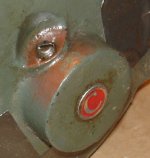Grey Rider
Hot Rolled
- Joined
- Jun 13, 2006
- Location
- Dayton, OH
Please excuse me if this is inappropriate for this forum, but I'm stumped.
I've got an old (ca. 1950) Century Polyphase motor, 1 hp. It has what I can only describe as a "unique" lubrication scheme. It has just the one, single plug in the bearing housing as shown in the photo below.
It uses ball bearings, which implies it needs grease. But there's no drain plug for removing the old grease! Everyone tells me to put grease in there, but that doesn't seem right, since there's no way to remove old grease. Also, although I can't see in there very well, I don't see any evidence of any grease ever being in there.
This is an old South Bend lathe motor, and when installed the bearing plugs are pointing UP. I had the motor removed for about a month, sitting with the plugs pointing DOWN, and a small quantity of oil has run out of the bearings through the plugs (which I had loosely installed). I know this could've run out from the grease.
I have obtained quite a few old Century motor documents for polyphase squirrel-cage induction motors from the Smithsonian. But none of the literature describes this specific housing. The literature says the motors either have ball bearings, which require grease, or sleeve bearings, which require oil.
Sleeve bearings have oilers and a drain plug. Ball bearings have 2 drain plugs - one for pumping grease in, and one for draining out old grease. Nowhere is the single-plug housing shown in any of the literature.
I don't want to pump any grease in this thing, so if I'm going to add grease I'll do it in a small quantity by sort of pushing it in with my fingers. The local motor repair shop gave me some old-timey grease that would be compatible with any old-timey factory grease that might have been in there.
But I don't want to install grease if this motor was meant for oil!
Do any of you have any ideas? I'm so conflicted over this!
Ryan
I've got an old (ca. 1950) Century Polyphase motor, 1 hp. It has what I can only describe as a "unique" lubrication scheme. It has just the one, single plug in the bearing housing as shown in the photo below.
It uses ball bearings, which implies it needs grease. But there's no drain plug for removing the old grease! Everyone tells me to put grease in there, but that doesn't seem right, since there's no way to remove old grease. Also, although I can't see in there very well, I don't see any evidence of any grease ever being in there.
This is an old South Bend lathe motor, and when installed the bearing plugs are pointing UP. I had the motor removed for about a month, sitting with the plugs pointing DOWN, and a small quantity of oil has run out of the bearings through the plugs (which I had loosely installed). I know this could've run out from the grease.
I have obtained quite a few old Century motor documents for polyphase squirrel-cage induction motors from the Smithsonian. But none of the literature describes this specific housing. The literature says the motors either have ball bearings, which require grease, or sleeve bearings, which require oil.
Sleeve bearings have oilers and a drain plug. Ball bearings have 2 drain plugs - one for pumping grease in, and one for draining out old grease. Nowhere is the single-plug housing shown in any of the literature.
I don't want to pump any grease in this thing, so if I'm going to add grease I'll do it in a small quantity by sort of pushing it in with my fingers. The local motor repair shop gave me some old-timey grease that would be compatible with any old-timey factory grease that might have been in there.
But I don't want to install grease if this motor was meant for oil!
Do any of you have any ideas? I'm so conflicted over this!
Ryan



